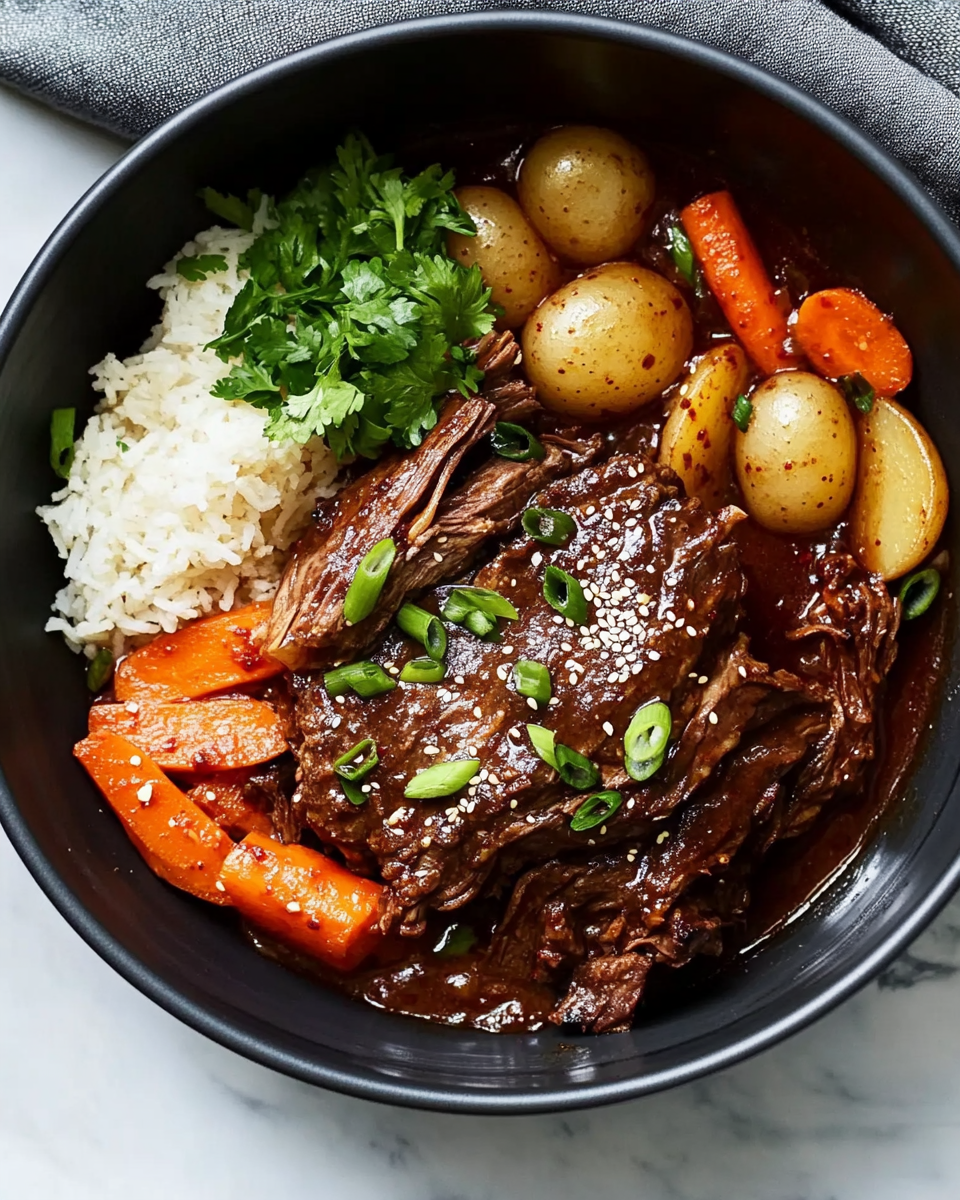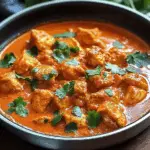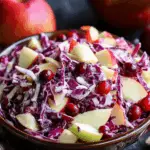The Origins and Influence of Korean Flavors
Korean cuisine is known for its distinctive balance of spicy, sweet, salty, and savory flavors. Gochujang, a fermented red chili paste, is a staple ingredient in Korean cooking and adds both heat and depth of flavor to dishes. Alongside soy sauce and sesame oil, it creates a layered taste profile that distinguishes Korean dishes from other Asian cuisines.
Incorporating these ingredients into a classic pot roast is a wonderful way to bring a new dimension to a beloved comfort food. This fusion approach respects the traditions of slow cooking tender beef while celebrating the boldness and complexity of Korean seasoning.
Why Choose a Chuck Roast?
Chuck roast is the ideal cut for this recipe because it’s well-marbled with fat and connective tissue, which breaks down during long, slow cooking to create tender, juicy meat. This cut becomes incredibly flavorful and moist when braised, soaking up the rich sauce and spices.
Slow cooking in a covered pot allows the beef to become fork-tender and infused with the fragrant Korean-style broth, making every bite deeply satisfying. The vegetables like carrots, celery, and potatoes also absorb the savory sauce, making them a delicious complement to the beef.
The Role of Gochujang and Other Korean Ingredients
Gochujang is the heart of the Korean-style pot roast’s distinctive flavor. This thick, fermented chili paste combines heat, sweetness, and a subtle fermented tang that enriches the broth. Its presence transforms the traditional pot roast sauce into something unique and exciting.
Soy sauce brings salty umami notes that enhance the natural flavors of the beef, while brown sugar balances the spiciness of the gochujang with a gentle sweetness. Sesame oil adds a toasty aroma and smoothness that rounds out the dish.
The combination of garlic and fresh ginger introduces warmth and complexity, elevating the flavor profile beyond a typical pot roast. These ingredients are common in Korean cooking and give the dish its authentic flair.
Cooking Technique and Its Importance
The cooking method for this Korean-style pot roast is crucial to achieving the perfect texture and taste. The beef is first browned to develop a caramelized crust, locking in juices and adding a rich depth of flavor through the Maillard reaction. This step is essential for creating complexity in the final dish.
After browning, the meat braises slowly in a flavorful liquid composed of beef broth, gochujang sauce, soy, and aromatics. Slow braising at low temperature allows the collagen in the chuck roast to melt, resulting in tender, succulent meat that falls apart easily.
The vegetables are cooked alongside the meat, absorbing the rich braising liquid and softening to the perfect consistency. This one-pot cooking approach not only enhances flavor but also makes cleanup easier, ideal for busy home cooks.
Serving Suggestions and Pairings
This Korean-style pot roast is wonderfully versatile and pairs well with a variety of sides. The traditional accompaniment would be steamed white rice, which absorbs the flavorful sauce beautifully and balances the spicy-sweet notes of the dish.
Kimchi, a fermented Korean side dish made of spicy pickled vegetables, is an excellent accompaniment that adds a crunchy texture and refreshing acidity to the meal, cutting through the richness of the braised beef.
For those looking to add more vegetables, sautéed greens like bok choy or spinach can complement the dish’s hearty flavors. A simple cucumber salad with a light vinegar dressing can also add brightness to the plate.
Health and Nutritional Considerations
While pot roast is often seen as a comfort food that can be rich and heavy, this Korean-style version offers a balanced meal rich in protein and vitamins from the vegetables. The slow cooking method preserves nutrients, and the incorporation of vegetables increases fiber content.
Gochujang, made from fermented soybeans and chili peppers, contains probiotics that can support gut health, although this benefit is more prominent in fermented foods consumed fresh. Using lean cuts and moderate amounts of oil keeps the dish satisfying without being overly indulgent.
Why This Recipe Works for Home Cooking
One of the greatest strengths of this Korean-style pot roast is how approachable it is. Despite its bold flavors, the recipe requires no complicated techniques or exotic equipment—just a good quality pot roast, common Korean pantry ingredients, and time.
This dish is perfect for meal prepping or family dinners because it can be made ahead and tastes even better the next day once the flavors have melded. It’s a fantastic recipe to make on a weekend and enjoy throughout the week.
Variations and Customizations
While the traditional recipe uses chuck roast, you can experiment with other cuts of beef such as brisket or short ribs for different textures and flavors. Vegetables can also be swapped based on what you have on hand—parsnips, sweet potatoes, or daikon radish work beautifully in this dish.
If you prefer a spicier kick, increase the amount of gochujang or add fresh sliced chili peppers during cooking. For a milder version, reduce the gochujang and balance with more soy sauce and sugar.
This recipe is also adaptable to dietary preferences. You can make it gluten-free by using tamari instead of soy sauce, or make it paleo-friendly by substituting brown sugar with coconut sugar or honey.
The Cultural Fusion Appeal
This dish exemplifies the beauty of fusion cooking—honoring a traditional Western pot roast while incorporating distinctly Korean flavors to create something new and exciting. It appeals to food lovers who enjoy exploring global cuisines and appreciate the harmony of flavors from different cultures coming together.
Conclusion
Korean-style pot roast is a delicious, hearty, and comforting meal that breathes new life into a classic dish by infusing it with vibrant Korean flavors. The marriage of tender slow-braised beef, spicy-sweet gochujang, and aromatic vegetables results in a unique and satisfying culinary experience that’s perfect for family dinners or entertaining guests.
Whether you’re a seasoned home cook or new to Korean cuisine, this recipe offers an accessible way to explore the depth of Korean flavors while enjoying the soul-soothing qualities of a traditional pot roast. Its versatility, ease of preparation, and robust taste make it a dish you’ll return to again and again, especially during colder months when comfort food reigns supreme.
Embrace this fusion dish as a celebration of cultural flavors and slow-cooked goodness—it’s more than just a meal, it’s an experience of warmth, tradition, and bold tastes on every plate.






